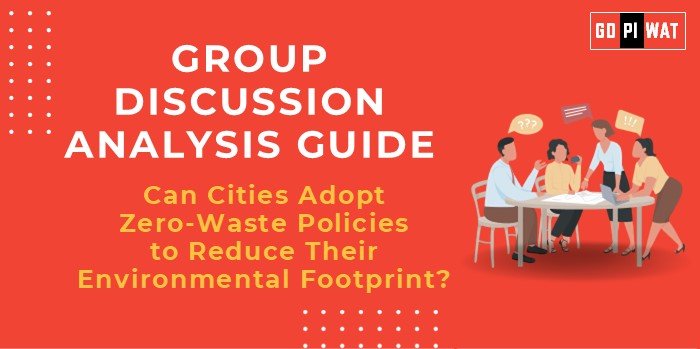📋 Group Discussion (GD) Analysis Guide: Can Cities Adopt Zero-Waste Policies to Reduce Their Environmental Footprint?
🌐 Introduction to the Topic
Opening Context: Cities generate 2.01 billion tonnes of municipal waste annually, with at least 33% of it not being managed in an environmentally safe manner. Adopting zero-waste policies is a transformative step toward sustainability.
Topic Background: The zero-waste concept focuses on designing, managing, and reducing waste while maximizing recycling and composting. Cities like San Francisco have set ambitious goals to achieve zero waste, serving as global case studies.
📊 Quick Facts and Key Statistics
- Global Urban Waste Generation: 2.01 billion tonnes annually (World Bank, 2023).
- San Francisco’s Diversion Rate: Over 80%, one of the highest globally.
- Plastic Waste Contribution: Cities account for 60% of plastic waste leakage into oceans.
- Zero-Waste Commitment: Over 300 cities globally have adopted zero-waste frameworks.
- India’s Waste Management Gap: Only 30% of waste is scientifically processed (CPCB, 2024).
👥 Stakeholders and Their Roles
- Local Governments: Policy creation, infrastructure development, enforcement.
- Private Sector: Investment in recycling and waste-to-energy technologies.
- Citizens: Responsible waste segregation and reduction.
- NGOs & International Bodies: Advocacy, capacity building, and technical support.
🏆 Achievements and Challenges
Achievements
- San Francisco’s Zero-Waste Program: Diverted 80% of waste from landfills since 2012.
- Swachh Bharat Abhiyan in India: Improved urban cleanliness and citizen participation.
- European Union Circular Economy Policy: Reduced landfill dependency across member states.
Challenges
- Behavioral Barriers: Lack of awareness and participation.
- Infrastructure Deficiency: Insufficient recycling and composting facilities.
- Cost: High initial investment for zero-waste programs.
🌍 Global Comparisons
- Japan’s Kamikatsu Town: Achieves an 80% recycling rate through strict segregation policies.
- Sweden: Combines recycling with waste-to-energy, achieving almost zero landfill waste.
📋 Case Studies
- Pune, India: Successful waste-pickers’ cooperative managing urban waste effectively.
🗣️ Structured Arguments for Discussion
- Supporting Stance: “Zero-waste policies are essential for mitigating urban pollution and conserving resources.”
- Opposing Stance: “The financial and infrastructural constraints make zero-waste adoption impractical for most cities.”
- Balanced Perspective: “While zero-waste policies are ideal, phased implementation with scalable models is key to success.”
🔑 Effective Discussion Approaches
- Opening Approaches:
- “Cities produce more than half the world’s waste; zero-waste policies are no longer optional.”
- “With cities accounting for 70% of greenhouse gas emissions, zero-waste initiatives complement urban climate strategies.”
- Counter-Argument Handling:
- “The financial challenges can be mitigated by public-private partnerships and green bonds.”
- “Successful examples from cities like Kamikatsu demonstrate the feasibility of zero-waste policies.”
📈 Strategic Analysis of Strengths and Weaknesses
- Strengths: Sustainable resource management, reduced environmental impact.
- Weaknesses: High initial costs, dependency on citizen participation.
- Opportunities: Green job creation, circular economy alignment.
- Threats: Economic feasibility, resistance to change.
🎓 Connecting with B-School Applications
- Real-World Applications: Urban management projects, policy design, and waste-to-energy startups.
- Sample Interview Questions:
- “What role do zero-waste policies play in achieving SDGs?”
- “How can B-schools contribute to sustainable urban waste management?”
- Insights for B-School Students: Explore policy frameworks, analyze case studies, and develop actionable models.


